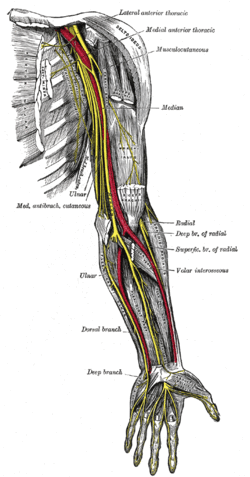- Cubital fossa
-
Cubital fossa 
Ulnar and radial arteries. Deep view. Latin fossa cubitalis The cubital fossa is the triangular area on the anterior view of the elbow of a human or other hominid animal. It is colloquially known as the "elbow pit".[1]
Contents
Boundaries
- superior (proximal) boundary - an imaginary horizontal line connecting the medial epicondyle of the humerus to the lateral epicondyle of the humerus
- medial (ulnar) boundary - lateral border of pronator teres muscle
- lateral (radial) boundary - medial border of brachioradialis muscle[2]
- apex- it is directed inferiorly, and is formed by the meeting point of the lateral and medial boundaries
- superficial boundary (roof)- skin, superficial fascia containing the median cubital vein, the lateral cutaneous nerve of the forearm and the medial cutaneous nerve of the forearm, deep fascia reinforced by the bicipital aponeurosis (a sheet of tendon-like material that arises from the tendon of the biceps)
- deep boundary (floor)- brachialis and supinator muscles
Contents
The cubital fossa contains four main vertical structures (from lateral to medial):
- The radial nerve is in the vicinity of the cubital fossa, located between brachioradialis and brachialis muscles. It is often[3] but not always[4] considered part of the cubital fossa.
- The biceps brachii tendon
- The brachial artery. The artery usually bifurcates near the apex (inferior part) of the cubital fossa into the radial artery (superficial) and ulnar artery (deeper)
- The median nerve
When the radial nerve is included, one can also use the mnemonic for lateral to medial: "Really Need Beer To Be At My Nicest".[3] When the radial nerve is excluded, one can use the mnemonic TAN, for "Tendon Artery Nerve".
The ulnar nerve is also in the area, but is not in the cubital fossa; it occupies a groove on the posterior aspect of the medial epicondyle of the humerus.
Several veins are also in the area (for example, the median cubital vein, cephalic vein, and basilic vein) but these are usually considered superficial to the cubital fossa, and not part of its contents.
Clinical aspects
During blood pressure measurements, the stethoscope is placed over the brachial artery in the cubital fossa. The artery usually runs medial to the bicepital tendon. The brachial pulse may be palpated in the cubital fossa also just medial to the tendon.
The area just superficial to the cubital fossa is often used for venous access (phlebotomy). A number of superficial veins can cross this region. It may also be used for the insertion of a peripherally inserted central catheter.
Historically, when (venous) blood-letting was practiced, the bicipital aponeurosis (the ceiling of the cubital fossa) was known as the "grace of God" tendon because it protected the more important contents of the fossa (i.e. the brachial artery and the median nerve).
References
- ^ Seminar with Alice Knight, St. Cuthbert's Society, University of Durham
- ^ "Chapter 9: THE ARM AND ELBOW". http://www.dartmouth.edu/~humananatomy/part_2/chapter_9.html#chpt_9_cubital_fossa. Retrieved 2008-01-05.
- ^ a b Mnemonic at medicalmnemonics.com 1271 45 631 1283
- ^ lesson4cubitalfossa at The Anatomy Lesson by Wesley Norman (Georgetown University)
Additional images
See also
References
External links
Upper limb Lower limb General anatomy: systems and organs, regional anatomy, planes and lines, superficial axial anatomy, superficial anatomy of limbsCategories:- Upper limb anatomy
- Human anatomy
Wikimedia Foundation. 2010.



